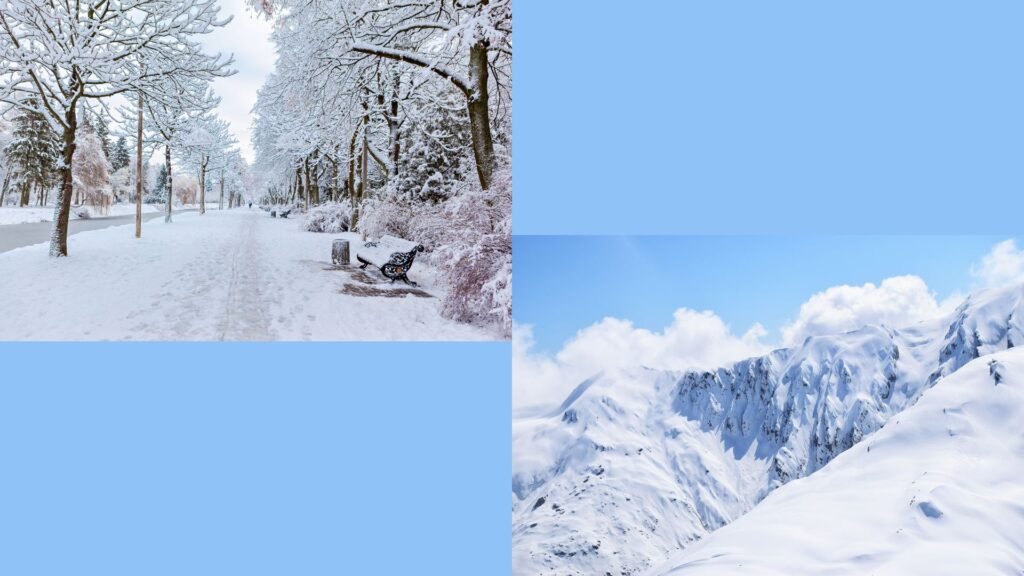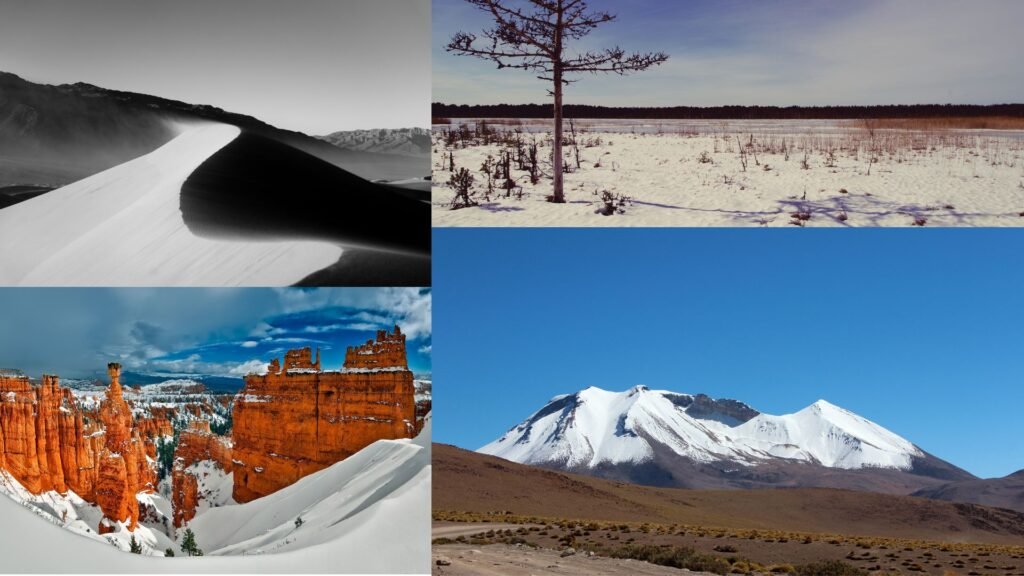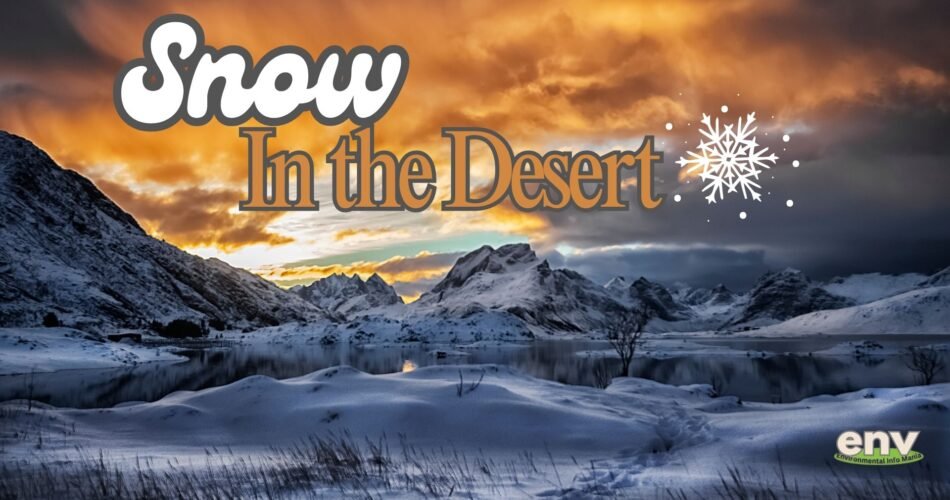This blog is a detailed overview of the Climatic Condition Snow in the Desert. This also includes the Snowfall with its types and Desert Biome. It also contains Reasons of Snowfall in Desert. In the end, It contains few Remarkable Instances of Snowfall in the Desert. This is a complete explanation of dangerous Climate Change Impacts on Earth.
1. What is called a Snowfall?
A snow fall is a natural phenomena of falling snow at a specific location in a given time period. It is basically the amount of Snow that falls on the surface of a region at particular time.
Snow fall is beautiful natural phenomena and it is worth watching to see the snow falling and snow accumulation on the surface of the Earth. It occurs when the temperature of the region reaches 0°C or colder than that. Falling snow have many variation according to extent of Climatic or weather conditions. As snowfall is restricted to Colder regions, the Snowfall in relatively hot regions, is not usual and is always rare incident in the Climatic History of the Earth. This kind of incidents, are examples of Rare and Extreme Impacts of Climate Change on Earth. We have seen many incidents related to unpredictable Snow at unusual Places around the Globe across passing years. Following are some Types of Snowfall:
i. Snow Flurries:
Light snow falling for short durations is the condition of Snow Flurries. It does not accumulate and light dusting is seen in this type of Snowfall.
ii. Snow Showers:
When the snowfalls with varying intensities for a brief period of time, it is known as Snow Shower. Accumulation of snow on the infrastructure and ground is possible at some extent.
iii. Snow Squalls:
When there is intense Snow showers with strong and dusky winds, this condition is Snow Squalls. Accumulation shows significant role in this type of Snowfall.
iv. Blowing Snow:
When the snow is completely drives with the help of wind and reduces visibility, it is Blowing Snow. It can be in two forms, Snow falling from the sky, or loose snow blowing from the ground with wind.
v. Blizzards:
Blizzards are the type of snowfall is characterized by 35mph wind with blowing snow that highly effects the visibility. The visibility may reduce for about 1/3 miles and for at least 3 hours.
These are the types of Snowfall. We will discuss the Snow in the Desert in this Blog.

2. What is the definition of a Desert?
A Desert is a region that is dry because it receives low Precipitation less than 25 centimeters annually. This is the reason it lack plants but contain Unique Flora and Fauna and creates a Biome.
Deserts are the driest places on Earth. They receive a very little amount of Water and nutrients through Precipitation and they cannot support normal plant’s development. There are unique species of Flora and Fauna in the deserts that makes it diverse Biome with remarkable species. The temperature of deserts is hot and there is dryness. People and animals cannot survive in deserts if Water and Food is not supplied to them from outside of the desert. Unusual Precipitation or Snow fall in the Desert have always been so unbelievable Environmental Incident in the World. It is a dangerous and extreme Impact of Climate Change if driest place on Earth receives Snowfall. This blog discusses the concept Snow in the Desert.
3. What is Snow in the Desert?
Imagine the flowing sands of a desert suddenly get layers of fresh white snow. This unusual contrast of snow in desert region is a rare and worth-seeing phenomenon. However it feels uncertain, snowfall in deserts is a reality under specific weather patterns. This Snow has intense impacts on the environment, wildlife, and even local communities.
In the phenomenon of Snow in the desert two crucial elements must align. These two are cold temperatures and sufficient moisture. Mostly, deserts cool very quickly at night due to less humidity, but snow needs temperature to drop more than freezing. This can occur when cold waves or polar air masses reach these areas. When this cold air add up with moisture in the atmosphere, it produces snow, converting the desert into a landscape depicting white winter.
The deserts that are located on the heights, like areas of the Mojave, Deosai, and the Tabuk region in Saudi Arabia, are especially prone to snowfall. It is because of the fact that higher altitude brings naturally low temperatures. These places occasionally receive snow in winter months when cold air moves through. This condition basically occurs due to the Extreme Climate Change Impacts.
4. Explain the Meteorology behind rare snowfalls?
Deserts are recognized for their extreme conditions, characterized by sweltering temperatures throughout the day. And it often drops surprisingly at night. Snowfall in these regions requires a blend of specific conditions that might seem improbable. But these occur occasionally, leading to an breathtaking winter land where we least expect it.
Polar Air Masses and Cold Fronts:
Sometimes, cold air masses from the Polar regions or Arctic front lines slides down into desert region. When these cold fronts are dragged into desert regions, they can cause significant drops in temperature. It occasionally brings it below freezing. If there’s humidity present in the air, this rare blend can result in snowfall.
High Elevations:
While we mostly think of deserts as flat and infertile many deserts specifically those in mountainous areas are regions at high altitudes. These areas at heights naturally have cooler temperatures. This fact increases the likelihood of snowfall in colder seasons. The Deosai Plains in Pakistan are a high-altitude desert so the height there supports occasional snow.
Climate Variations and Weather Irregularity:
Climate changes and unimaginable weather patterns are leading to rare temperature shifts and weather events. Deserts are not spared from these conditions. Some researchers suggest that these unusual snowfalls might become more common as global weather continue to shift.
Moisture:
Snow is very unpredictable event in desert regions, it is because there is very little moisture in this region. But when moisture occurs in such areas, it play a crucial part in ecosystem. This moisture may turn into precipitation including snow. So, we can say that moisture is one of the significant reasons for snowfalls in desert.
These are some of the possible reasons that can cause Snow in the Desert. All of these are directly related to Climate Change and its worse impacts on Earth. We will discuss some recent Scenarios and Environmental Impact of Snowfall in the Desert.
5. What are the Environmental Impact of Snowfall in Desert Regions?
The environmental impacts of snow in deserts are as follows:
Desert Flora and Soil:
The Snow in the desert takes valuable moisture that is a rare resource in arid regions. As the snow melts, the water slides into the ground and lead to temporarily nourishing dormant plants. It also work for helping seeds fertilize, and sometimes even improving a brief desert bloom as flowers and grasses enter to life. Although, abrupt frost can damage sensitive desert plants that aren’t habitual to freezing conditions.
Impacts on Wildlife:
Animals found in the desert are adapted to handle much heat but cold weather can create challenges for them. The snow makes it a challenge for many animals to look for food and shelter. That lead to potentially drives them to show rare behaviors to survive. For species that count on camouflage to hide from hunters, a white snowy scene can make them more sensitive to environment.
Flash Flooding and Erosion:
When the snow melts it can create an immediate powerful runoff that leads to erosion. Desert soils are often unattached and have less vegetation to keep them stable. So in this condition the runoff from melting snow can shape new channels, wash soil, and even result as flash floods in low level areas. The desert land is entirely open for erosion and runoff. So, in this condition high extent of Soil Erosion may occur in Deserts.
The Albedo Effect:
The Snow-covered ground throws back sunlight, which for sometime lowers the local temperature due to cooling. In a desert, where the sun mostly heats the earth intensely the cooling effect can change local weather patterns. This can be called as short-term Global Cooling of the Earth’s Climatic Systems. The snow increase the Earth’s Albedo while it stays.
Ecosystem Boost:
Snow at the desert can lead to a short-lived increase in biodiversity. Specifically after the melting and new plants attracts pollinators, insects, and small animals. This temporary richness can support animals to advance the food chain. This also offers a rare chance for desert ecosystems to flourish. This is a benefit of Snowfall in desert because normally desert does not support much of Biodiversity.
Agricultural Losses:
Snow is extremely poisonous for the ripen crops. It can damage these crops and cause the wastage of food crops and agriculture loss. In extreme conditions, it is difficult to grow new crops because of extreme cold, so farmers face decline in their yield and eventually their income is reduced at great extent.
These are the Environmental Impacts of Snowfall in the Desert. It may be positive and negative at the same time for the whole Desert Biome.
6. What are the Economic Impacts of Desert Snow?
Following are some of the significant Economic Impacts of Desert Snow:
i. Tourism:
As we know, Snow in desert is a rare event that is unique to the visitors and tourists. When people get to know about this rare weather event, they prefer to witness its beauty and make memories. So, the tourism is boosted and it leads to the economic growth of the relative location and region.
ii. Water Source:
Desert snow brings a huge amount to water to the driest lands. When this snow melts, the water turns into water resource for agriculture and human use. This water also increase moisture in the soil and can also utilize in Hydropower generation on small scale for populations living there.
iii. Damage of Infrastructure:
Infrastructure includes the roads, pipelines, buildings etc. that are designed according to the high temperature in the deserts. When snowfall occurs, this can damage the roads and pipelines that can be costly for the government and people of that region. This may lead to disruption in transportation and other such activities
iv. Emergency Response:
Emergency response includes the removal of snow, rehabilitation of people and all the requirements to tackle the unexpected weather conditions. In case of Desert snow, the response in emergency may be extremely costly because the temperature suddenly gets extremely cold and ways become disrupted and disturbed.
These are some of the Economic Impacts of Snow in the Desert.
6. What are some Historical Snow events in Desert region?
Snowfall in the desert have never been common and usual on Earth. We always find it stunning to see coldest weather events in the driest places of the Earth. But due to Extreme Impacts of Climate Change, we have seen many such instances that show Snow in the dry Deserts of the Earth.
Snow in Sahara Desert:
Sahara desert is hottest desert. The Sahara received snowfall many times in recent years. Snow covered the popular red dunes of Ain Sefra, a small region known as the “Gateway to the Sahara.” Photos of snow laden dunes went viral, as the blend between white snow and rust color sand looked almost divine.
Snow in Atacama Desert:
The Atacama is one of the driest places on Earth, with areas that see no measurable rainfall for years. In 2011 and 2017, rare cold waves brought snowfall. The white layer across the arid location provided a unusual presence of moisture. It led to an explosion of flowers in the weeks following the melting of snow.
Arabian Desert Snowfall:
Saudi Arabia’s Tabuk region that is situated in the Arabian Desert, left locals and visitors alike in wonder. With extreme temperature dropping well below freezing point, the desert area was covered in snow. These happenings brought joy to population but also caused disturbance as people were not adapted to the rarely cold weather.
USA, Mojave Desert:
This desert is known for its extreme heat which includes areas around Las Vegas that received snowfall in 2019. The snow covered Joshua trees and cacti. With transforming the iconic desert landscape into a colder sight that crowds of people witnessed there.
Snow Deosai National Park, Pakistan:
Deosai Plains in Pakistan that are mostly called as the “Land of Giants.” This is a unique heighted desert plateau situated at around 4,000 meters above sea in the Gilgit-Baltistan region. Snowfall here is an event every year. But it is remarkable. The snow changed the already uneven landscape into a breathtaking view of white expanses and snow-covered mountains.
7. Link between Climate Change and increasing frequency of unusual weather events?
Climate Change is a prominent natural phenomenon that drives Weather events throughout the world. Climatic conditions and changes are the reason behind heat waves, snowfall, and other natural disasters. Odd weather events includes rare and unpredictable weather events such as high temperature in areas that are colder most of the year etc. Climate changes may lead to heat waves, high tides, extreme cold and every odd weather seen on the globe.
When we talk about Snow in the desert, it is also one of the odd weather event occurred in the locations that are mentioned in heading above. As we know that deserts are driest places on Earth. There is little atmospheric moisture, water is rare and is almost lifeless. When snowfall begins in a desert biome, there is a rare condition in which atmospheric moisture produces in the desert because of climatic variations, including cold fronts, weather fluctuations etc. In the same way, whenever there is the occurrence of any odd weather events, at the back there is some unusual climatic changes going on in the atmosphere or on Earth. So, we can say that rare events in weathers are directly drives by Climate Change. We can also say that Desert snow is an indicator of extreme Climate changes.
8. Mention Facts vs Myths about Desert Snow.
Following are the Facts vs Myths about Desert Snow:
Facts vs Myths
- Desert Snow is rare but possible. Deserts never snow.
- Both Cold and moisture is need of it. Not all the flakes are alike.
- Snow is not always white. Snow is always white.
- Is sometimes crystal clear. It is always beautiful.
These are some of the Facts and Myths about Deserts Snow. This blog contains all information about Snow in the desert.

9. Conclusion
Snowfall in deserts is one of most astonishing display of nature. It occurs by transforming known sandy or rocky landscapes into unreal scenes resembling to the Arctic than the desert region. This is a beautiful sight but these rare events have a prominent impact on the ecosystem. It ranges from supporting plant nourishment to challenging wildlife and shaping the landscape. It even influences short-term weather events. We discussed Snowfall Types, Desert Biome, Environmental Impacts of Snowfall in desert, Reasons behind this Climate Change impacts and the Historic events of Desert Snow in world.
To learn about more Topics, Click the links below:


Comments